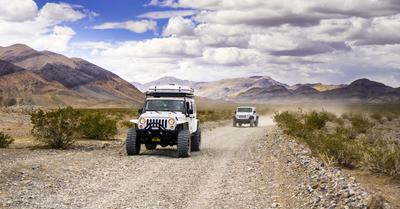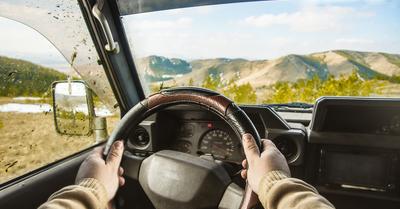Active suspension gives a driver incredible control over their vehicles on different types of terrains, but what exactly is off-road active suspension?
Suspensions come in three types: passive, semi-active, and active. Passive suspensions use springs that mainly react to the terrains that you're driving on. Semi-active suspensions use varying shock absorbers to match varying road conditions. Neither of these is particularly great for off-roading. This is where active suspensions come in.
An off-road active suspension is a system that controls the vertical movement of each of the vehicle's wheels. This is usually done by hydraulic actuators that work to raise or lower the chassis at each wheel.
However, while an active suspension is an ideal choice for off-roading enthusiasts, many beginners are still not aware of its importance. Keeping that in mind, here we will take a quick look at off-road active suspensions and why you should care as an off-roading enthusiast.
As experienced off-roaders who have used various types of active suspensions for off-roading, we can tell you all there is to know about off-road active suspensions.
This article may contain affiliate links where we earn a commission from qualifying purchases.
Off-Roading and Suspension
If you routinely take your truck or SUV out for a spin, you'll notice a change in the suspension system's bumps. They'll feel harsher, and you'll notice them more frequently. This, however, is not necessarily due to the terrain's rough layout. When you notice your ride becoming harsher, it's usually due to a flattened suspension system.
The springs in the suspension are not going to spring back to their original shapes when the system is worn down. This means that if you're not careful and don't inspect your off-road suspension, you might end up with significant irreversible damage and an unusable car. Your safety on and off the trodden path may be jeopardized if you neglect your axle and springs.
Any off-road vehicle, arguably more so than any other kind of vehicle, can benefit from suspension changes. The goal of improving your system is to remove your vehicle's standard suspension and elevate the body and frame. The new installation not only provides more ground clearance to accommodate wider tires but also enhances suspension travel.
Suspension travel refers to the amount of vertical wheel movement that the system allows. It helps your vehicle make more effective and safe contact with the ground. You won't move an inch if your vehicle or ATV's wheels have minimal contact with the ground.
An active suspension for off-roading smoothes out bumps while also controlling your vehicle's stability. To reduce the severe effects of bumpy riding, springs absorb pressures that act on the wheels. The function of a suspension is to enhance the vehicle's handling during turns and braking and protect large loads.
However, before you invest in an off-road suspension system, consider the terrain you often travel, how fast you accelerate, and whether the vehicle is used for both off-road and highway driving. High speeds on sand and softer terrain necessitate different technologies than those used in rock crawling or harsh settings.
Understanding Active Suspension
The three competing goals of comfort, load carrying, and road holding have always been a compromise in vehicle suspension systems.
The suspension system must sustain the vehicle, offer directional control during maneuvers, and effectively isolate passengers and freight from road noise. Soft suspension is required for good ride comfort, whereas rigid suspension is required for insensitivity to applied stresses. A suspension setting that is halfway between the two is required for good handling.
Due to these competing objectives, suspension design has had to be a compromise, with the sort of purpose for which the vehicle was intended playing a big role. Active suspensions are thought to be a technique of expanding one's ability to define load carrying, handling, and ride quality attributes separately.
A passive suspension system can store energy in the form of a spring and dissipate it through a damper. Its specifications are normally set, with the goal of striking a balance between road holding, weight carrying, and comfort.
An active suspension system can store, dissipate, and introduce energy into the system. It can change its settings based on operational conditions and have information beyond the passive system's strut deflection.
Active suspension systems detect the forces acting on the wheels and modify the mechanical connections between the wheel and chassis assemblies on the fly to maintain the chassis level and/or absorb energy that's related to the wheel's vertical motion as efficiently as possible.
Additionally, with improved computer control, the driver may alter numerous suspension travel options and reactions while driving. A common example is a "Sport" mode, which produces a more dynamic reaction. "Semi-active" suspension systems can only alter the viscous damping coefficient of the shock absorber, not the spring rate.
An electronically operated valve adjusts the flow of hydraulic fluid inside the shock absorber to vary the dampening qualities of a basic semi-active suspension.
An electrically produced magnetic field is used in a more recent invention to successfully adjust the viscosity of a shock absorber fluid that retains metallic particles.
Mercedes-Benz has created a technology dubbed "Magic Body Control." This completely active technology analyzes not just the forces produced on the car's suspension system but also the condition of the terrain.
Two image sensors in the car's front actively monitor the road ahead, preparing the suspension ahead of time to adapt for unexpected changes in road surface height.
Purely Active Suspensions and Semi-Active/Adaptive Suspension
In general, there are two types of active suspensions: totally active suspensions and semi-active/adaptive options. Sub-categories can be found within the active system. It employs a type of actuator that allows the chassis/body to be raised or lowered separately at each wheel.
On the other hand, the semi-active suspension can merely adjust the stiffness of the shock absorbers to fit changing driving circumstances.
The purely active system uses a hydraulically or electromagnetically activated recuperative mechanism. With semi-active suspensions, it is controlled by a solenoid/valve or a magneto-rheological damper system.
The active system improves the ride quality and handling of the vehicle. It accomplishes this by maintaining the tires at right angles to the road in turns, resulting in improved traction control.
Furthermore, the system monitors vehicle body movement via various sensors fitted on the car body using an onboard computer. The onboard computer uses data calculated by proper control algorithms to govern the suspension's activity.
As a result, this technology can almost eliminate body roll and pitching fluctuations in a variety of driving situations, including braking, turning, and acceleration. It allows travelers to travel without feeling tired.
The active system is now available on premium cars from manufacturers. To set themselves apart from the competition, they employ bespoke acronyms. One such suspension system is Nissan's Active Ride Control.
The automobile suspension system significantly reduces body roll and improves ride comfort. The Adaptive Suspension or Active Suspension system, on the other hand, is a computer-controlled system that actively manages the vertical movement of the wheels matching to the vehicle chassis (body).
It provides a more refined and comfortable ride. In a passive/conventional suspension system, the road profile alone determines or influences the suspension system's whole movement.
Limitations
However, there is a limit, and while AS can help with load control, it isn't a miraculous remedy for exceeding the GVWR or towing limits. It's not for the dual hauling a 40-foot car transporter or the driver who is so far above GVWR that an airbag suspension with 110-PSI bag pressure is required.
There is no better alternative than Active Suspension for the owner who is within or within factory ratings and yet experiences any form of instability but doesn't want the trouble or unpleasant ride.
Suspension travel is another thing to think about. Because it rides on top of the rear eyelet of the leaf pack and the leaf spring, an active suspension system might not be right for you if you do any rock crawling or need the most movement the suspension can supply.
Even with that constraint, most off-road scenarios and ordinary trail driving are still possible with an AS system fitted. Light off-roading and Overlanding are a natural match for reasons that go back to its original purpose and design philosophy of boosting ride quality over rough roads.





